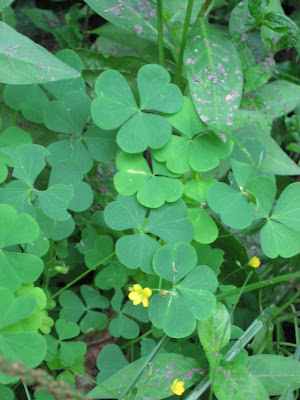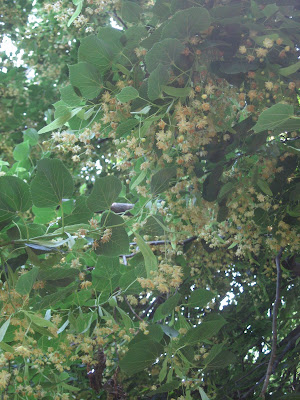First up we have dandelion (the jagged, vertical plant towards the center of the photo). One of the most common plants in New York, it's not always so good to eat--it can be very bitter--so if you're looking to harvest some, aim for the smaller, younger leaves, which are sweeter and more tender. Dandelion can be used in a number of ways in cooking; it's most commonly found in salads, but can also be sauteed and eaten, for example, over pasta:
Here we have some wood sorrell. It's fairly easy to recognize because it looks a lot like clover, and has tiny yellow flowers. Of all the greens I sampled today this was one of my favorites: eaten raw, it has a bright lemony flavor and a nice mustardy bite to it. Like a lot of the plants we found in the park, it can be eaten raw in salads or cooked into soups or stews:
The darker green, rough-edged leaves toward the center of this next photo are lamb's quarters, so named because their shape is reminiscent of, well, a lamb's quarter. The plant has a mild taste that is very similar to spinach, so you can use it in pretty much the same applications. One nice idea? Stew them together with some white beans, tomatoes, garlic and chicken broth:
Pictured next is a plant called Asian day flower. Justin said that the young leaves and shoots can be stir-fried, and that the small purple flowers can be used to garnish salads:
Here we have some sheep sorrel, so named because if you hold the leaf of the plant upside-down it sorta resembles a sheep's head with its ears. This was my favorite of the plants I sampled today: the leaves have a sharp, refreshing taste and a nice amount of moisture in them. It's recognizable by its stalks of dryish yellow flowers. A very common use for sheep sorrell, like the wood sorrell, is in soups:
This next plant is mugwort. OK, so you don't cook with mugwort, but it's notable for its medicinal purposes. Closely related to wormwood, the active ingredient in absinthe, mugwort is said to have relaxing and even mildly hallucinogenic properties when taken in a tea/infusion. Sweet!
Next up is burdock. Burdock root is commonly used in Japanese dishes, and has a flavor similar to mushrooms:
And the last of the edible plants we found, the linden tree. When its yellow flowers are in bloom, they smell strongly of honey and bees flock to them. You can dry the flowers and brew a tea out of them, or just put the fresh ones into your water bottle for a perfumed, subtly sweet drink:
So now that the educational portion of this post is concluded, let's get to the (more) fun part: the food. Justin made a truly delicious lunch for us that utilized many of the plants we had seen in the park, along with some delicacies from the green market as well as from Stone Barns. We had a complete meal: soup, sandwiches and salads. Here's a nice photo of the assembly process:
You can see the chilled soup, made from lamb's quarters, dandelion and amaranth, at the center of the blanket. And here are some closeups. The sandwiches pictured here are, on the bottom, cream cheese with smoked Long Island bluefish, wood sorrell and day lilies, and, on the top, egg salad (made from the eggs of Stone Barns chickens), sheep sorrell, and a liberal sprinkling of crisp Stone Barns bacon:
What can I say? Both sandwiches were outrageously delicious, which is a particular feat since I'm not crazy about bluefish and I don't usually care for egg salad. But how can anything covered in bacon be bad? Next up are the salads. The first has purslane, a crisp, acidic green, along with chickpeas, ricotta salata, capers and pine nuts in a lemon-honey vinagrette. Have you ever had a salad like that before?! I hadn't:
And the other salad, composed of chickweed, a green that tastes exactly like fresh, raw corn smells, in a tomato vinagrette with more ricotta salata. Corn and tomatoes in the summer? You can't go wrong:

Thanks again to Justin and all the Wes participants for one of the more memorable, and more delicious, meals that I've had in a long time.















No comments:
Post a Comment